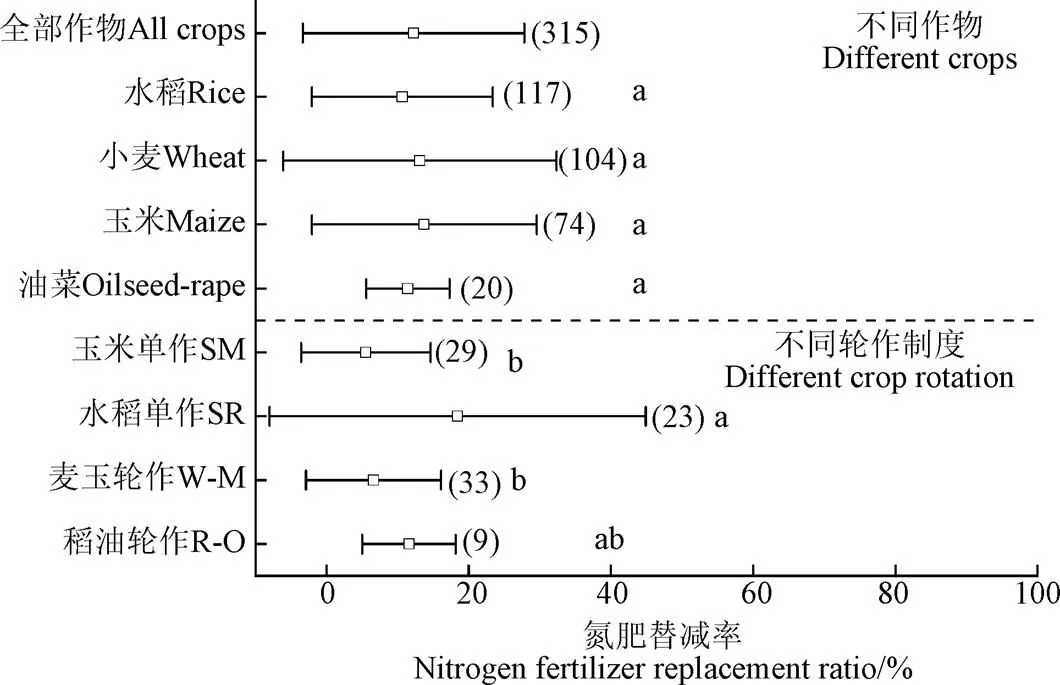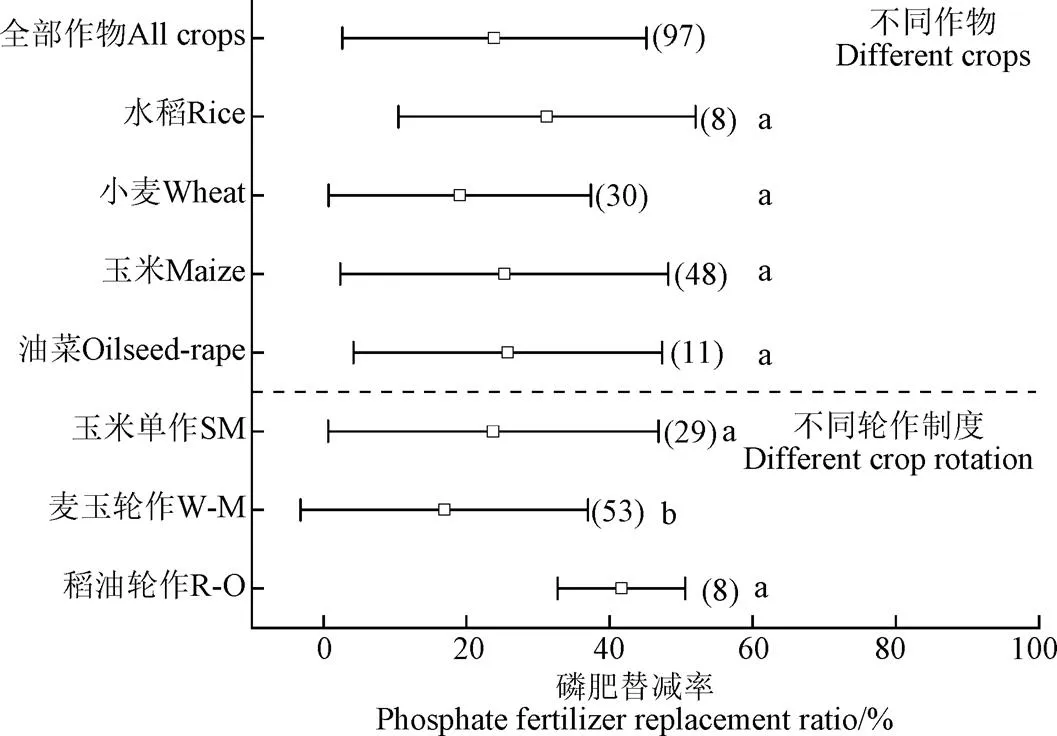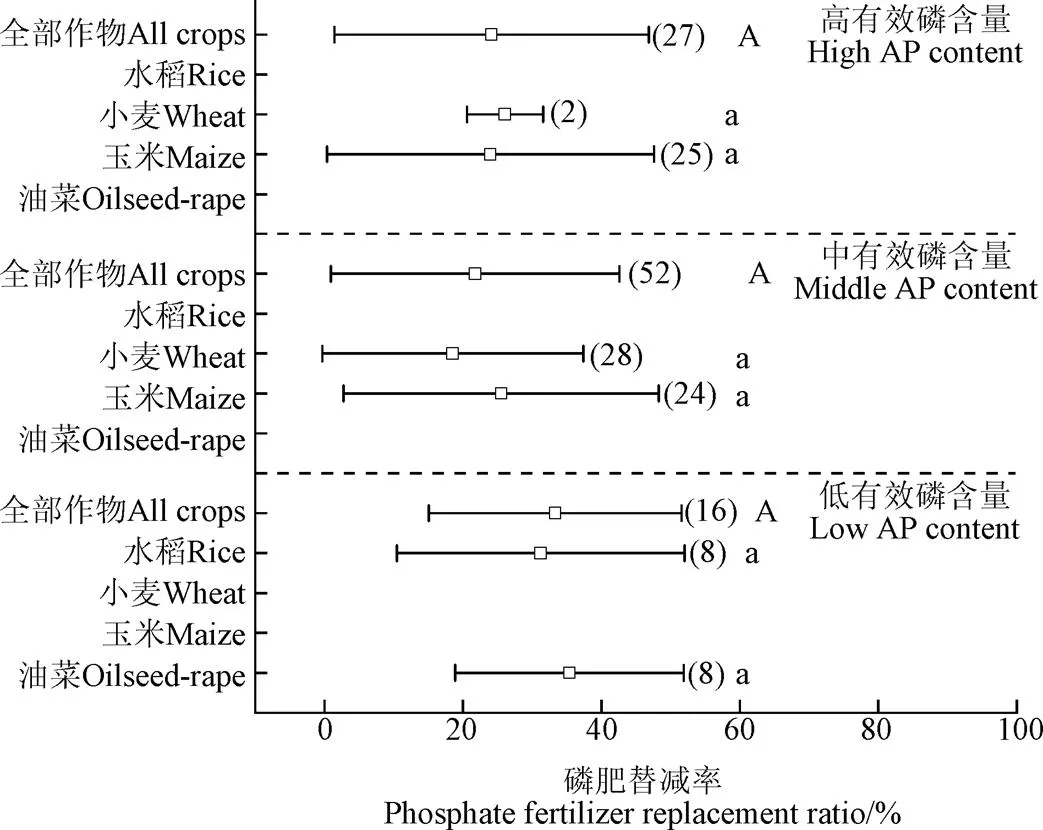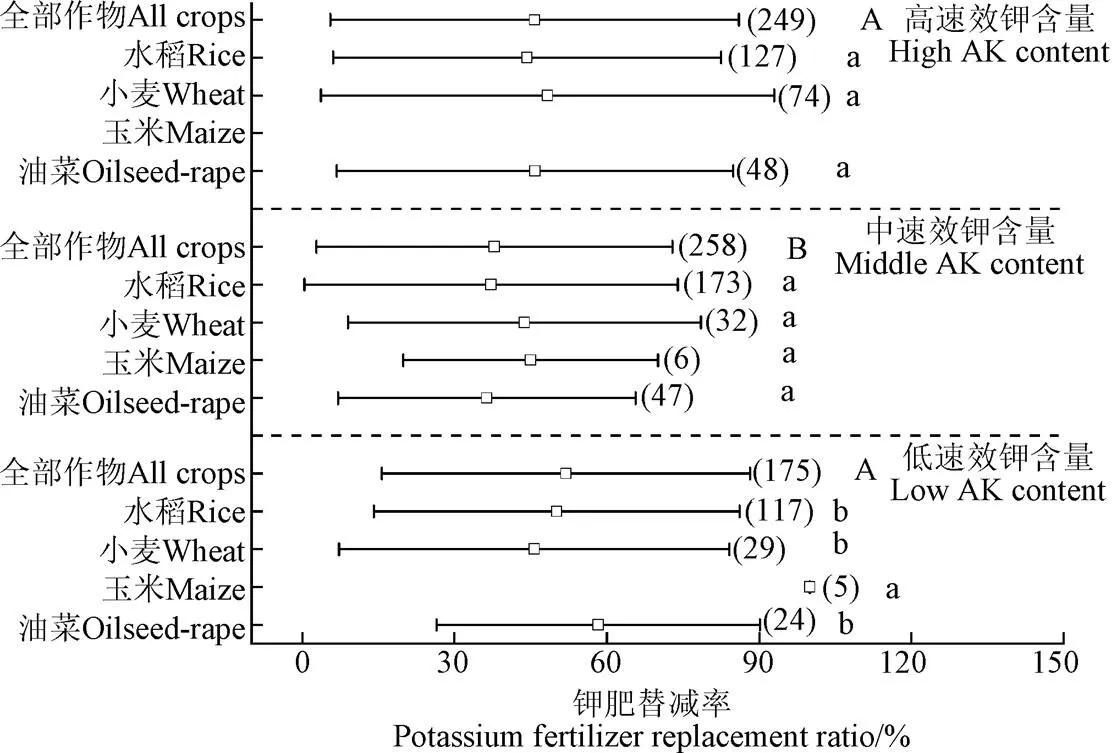基于田间试验的秸秆还田化肥替减潜力综合分析
侯素素,董心怡,戴志刚,巩细民,徐志宇,薛颖昊,张洋洋,李小坤,丛日环,鲁剑巍
基于田间试验的秸秆还田化肥替减潜力综合分析
侯素素1,董心怡1,戴志刚2,巩细民2,徐志宇3,薛颖昊3,张洋洋1,李小坤1,丛日环1※,鲁剑巍1
(1. 华中农业大学资源与环境学院,武汉 430070;2. 湖北省耕地质量与肥料工作总站,武汉 430070; 3. 农业农村部农业生态与资源保护总站,北京 100125)
秸秆含有丰富的营养元素,秸秆还田是实现化肥减量的重要途径。中国不同农区种植制度及土壤养分供应条件相差较大,秸秆还田化肥替减率存在差异,为明确不同种植制度及土壤养分条件下秸秆还田化肥替代率,该研究以水稻、小麦、玉米、油菜4种主要大田作物为研究对象,基于2000-2021年“中国知网(CNKI)”公开发表的文献数据和2013-2021年湖北省32个秸秆还田田间试验数据,对田间生产条件下主要农作物秸秆还田化肥替减氮、磷、钾肥比例进行计算,评估区域尺度的秸秆还田化肥节本潜力。结果表明,4种作物秸秆还田平均可替减氮肥12.2%、磷肥23.9%、钾肥43.5%。不同作物秸秆还田氮、磷、钾肥替减率差异均不显著(>0.05)。不同轮作制度下,水旱轮作体系(水稻单作和稻油轮作)氮、磷肥替减率较旱地轮作体系(麦玉轮作和玉米单作)分别高出5.0~12.9、18.0~24.8个百分点。此外,土壤养分供应能力是影响秸秆还田化肥替减潜力的重要因素。养分供应能力较低的土壤秸秆还田磷、钾肥可替减率较养分供应能力高的土壤则分别高出9.1~11.5、6.2~14.2个百分点。基于2020年各农作物种植面积和化肥消费量,中国水稻、小麦、玉米、油菜季秸秆还田可减施氮(N)、磷(P2O5)、钾(K2O)肥分别为239.48×104、227.73×104、451.98×104t,占当前氮、磷、钾肥消费量的12.6%、25.0%、48.5%,化肥节本可达到478.98亿元/a。研究结果为中国主要农作物化肥减施增效提供理论依据和数据支撑。
土壤;养分;秸秆还田;化肥替减率;土壤养分供应;轮作制度;田间试验
0 引 言
近年来,中国农作物秸秆可收集量稳定在8亿t左右[1-3],秸秆资源丰富。农作物秸秆含有大量的氮、磷、钾及中微量元素,宋大利等[4]评估了全国主要农作物秸秆氮(N)、磷(P2O5)、钾(K2O)养分资源量分别达到625.6×104、197.9×104、1 159.5×104t。随着国家对秸秆资源化利用的推动力度不断加大,秸秆还田尤其是直接还田比例明显提高。不同省份政府网站公布的数字显示,主要粮食作物秸秆还田比例已达到50%~70%[5]。
秸秆还田有利于保障粮食增产稳产[6-7]、提高土壤养分含量[8]、改善土壤物理性状[9]、优化农田生态环境[10],更重要的是在稳产或增产的前提下,连续秸秆还田可以减少化肥投入,实现化肥减施增效[11],推动农业绿色可持续发展。秸秆还田替代化肥的潜力主要取决于秸秆养分投入量和秸秆养分释放的速率。由此衍生出两种秸秆替代化肥的估算方法,一种是基于养分投入量的估算,即由秸秆养分资源量与秸秆还田比例估算可替减化肥量[12-13]。例如,宋大利等[4]提出不同作物秸秆还田可替减氮肥27.7%~71.1%、磷肥10.2%~27.7%、钾肥42.4%~135.4%。这种方法计算参数容易获取,因此使用较为普遍。然而此方法未考虑当季秸秆养分释放特征及其利用率等问题。另一种则是考虑秸秆还田养分当季释放率来计算[14-16]。例如,刘淑军等[17]估算全国不同区域水稻秸秆还田可分别替减10.9%~12.5%的氮肥、11.8%~17.1%的磷肥、116.2%~122.6%的钾肥,这种方法未考虑秸秆养分矿化后的损失。研究表明,尽管秸秆养分当季可矿化20%~30%,但仅有6.2%~14.3%[18-20]可被当季作物再吸收利用,85.7%~93.8%的养分则不能被当季作物吸收(主要储存于土壤库中或通过气体、淋溶、径流及侵蚀等途径损失)。因此这两种方法均在一定程度上高估了秸秆还田化肥替减率,田间实际生产应用上往往难以参考。近年来,随着秸秆还田化肥替减研究不断深入,不同区域的科研工作者广泛开展了秸秆还田化肥替减效果的田间试验[21-23]。但多数田间试验研究集中在单一田块、单一作物,缺乏针对不同种植制度或区域及不同养分供应能力土壤的相关整理与分析,因此不同田间试验得出的秸秆还田化肥替减率差异较大。
本研究通过收集2000-2021年已发表的秸秆还田化肥替减试验数据487组,结合本团队2013-2021年在湖北省32个县市开展的多年多点秸秆还田化肥替减试验数据641组,综合分析不同种植制度、不同土壤养分供应条件的水稻、小麦、玉米、油菜秸秆还田化肥替减率,在此基础上估算秸秆还田化肥减量节本潜力,以期在区域尺度上为秸秆还田化肥替减工作提供理论依据,在田间尺度上为秸秆还田化肥减量提供数据参考。
1 材料与方法
1.1 数据来源
1.1.1 文献数据
首先,在中国知网(http://www.cnki.net/)搜索并筛选2000-2021年发表的秸秆还田替减化肥相关文献,搜索关键词为“秸秆还田”“氮肥”“磷肥”“钾肥” “化肥替减”,共检索到183篇相关文献。其次,对所检索到的文献数据进行遴选。遴选具体标准如下:1)选择推荐施肥处理与秸秆还田替减氮肥、磷肥或钾肥处理;2)为避免部分文献设置的施肥量过高而导致的秸秆还田化肥替减率偏高,本研究选择推荐施肥量范围分别为氮肥(N)150~250 kg/hm2、磷肥(P2O5)40~120 kg/hm2、钾肥(K2O)50~150 kg/hm2;3)研究地点位于中国大陆地区;4)供试作物为水稻、小麦、玉米或油菜;5)大田试验,试验时段的起止年份清晰;6)试验数据应包含氮肥、磷肥或钾肥施用量、作物产量、土壤基础理化性质等。通过文献筛选,获得有效文献59篇,相关数据487组,其中氮肥替减相关文献32篇(224组数据),磷肥替减相关文献7篇(81组数据),钾肥替减20篇(182组数据)。试验点覆盖黑龙江、吉林、辽宁、内蒙古、甘肃、陕西、河北、河南、山东、四川、湖北、安徽、江苏、贵州、湖南、江西、浙江17个省份。
1.1.2 试验数据
选择本团队在2013-2021年湖北省32个县、市布置的秸秆还田化肥替减试验数据[21,24](含部分未发表数据),试验点包含武汉、武穴、汉川、钟祥、天门、潜江、应城、京山、大冶、老河口、荆州、枣阳、仙桃、掇刀、监利、孝昌、赤壁、沙洋、鄂州、安陆、松滋、谷城、麻城、崇阳、洪湖、南漳、随县、红安、孝南。选择推荐施肥处理与秸秆还田替减氮肥、磷肥或钾肥处理。经过处理筛选,获得相关数据641组,其中氮肥替减相关数据91组,磷肥替减相关数据16组,钾肥替减相关数据534组。
1.1.3 统计数据
4种主要农作物种植面积数据引自2021年《中国农村统计年鉴》。氮、磷、钾肥施用量和价格引自2019-2021年《全国农产品成本收益汇编》三年化肥(折纯)均价,即氮肥(N)4.58元/kg、磷肥(P2O5)5.34元/kg、钾肥(K2O)5.48元/kg。
1.2 数据计算与分析
1.2.1 秸秆还田化肥替减潜力与节肥成本
本研究以推荐施肥处理作为对照组,秸秆还田化肥减量处理为处理组。以统计数据为依据,分析秸秆还田化肥替减比例。将处理组和对照组产量进行比较,以处理组与对照组相比产量相差≥−5%视为没有减产,即平产和增产,两组的氮肥、磷肥或钾肥施用量之差除以对照组施用量视为氮肥、磷肥或钾肥替减率;相反,若处理组和对照组相比产量相差<−5%则将其视作秸秆还田化肥替减率为零。如果文献中数据以图的形式表示,则采用软件GetData Graph Digitizer 2.24软件进行数字化后提取[25]。
不同作物秸秆还田化肥替减率,以氮肥(N)为例,计算方法见式(1)。
R=(N−N)/N×100%(1)
U=Q/(2)
P=Q·R(3)
P=P+P+P(4)
式中R为氮肥替减率,%;N和N分别为对照组和处理组施氮量,kg/hm2;U为单位面积氮肥用量,kg/hm2;Q为氮肥施用总量,104t;为种植面积,104hm2;P、P、P分别为氮肥(N)、磷肥(P2O5)、钾肥(K2O)替减潜力,104t;为3种化肥总替减潜力,104t。
不同作物秸秆还田化肥替减节本潜力,以氮肥(N)为例,计算方法见式(5)。
C=10P·V(5)
=C+C+C(6)
式中C、C、C分别为氮肥、磷肥、钾肥节本潜力,108元;为3种化肥总节本潜力,108元;V为氮肥(N)价格,元/kg。
1.2.2 不同作物、种植制度和土壤养分供应条件的秸秆还田化肥替减率差异
本文根据不同土壤养分供应条件和种植制度将秸秆还田化肥替减试验效果进行分组。土壤养分分级参考全国第二次土壤普查养分分级标准[26]结合当前土壤状况,按照土壤有机质(soil organic matter, SOM)含量将土壤分为低有机质土壤(SOM<10 g/kg)、中有机质土壤(10 g/kg≤SOM<30 g/kg)和高有机质土壤(SOM≥30 g/kg);按照土壤有效磷含量(available phosphorus, AP)分为低磷土壤(AP<10 mg/kg)、中磷土壤(10 mg/kg≤AP<20 mg/kg)和高磷土壤(AP≥20 mg/kg);按照土壤速效钾(available potassium, AK)含量分为低钾土壤(AK<100 mg/kg)、中钾土壤(100 mg/kg≤AK<150 mg/kg)和高钾土壤(AK≥150 mg/kg)。
本研究收集文献涉及的种植制度主要包括玉米单作、水稻单作、麦玉轮作、稻油轮作、稻麦轮作。其中玉米单作试验点主要分布在辽宁、内蒙古、甘肃等省份;水稻单作试验点主要分布在吉林、浙江等省份;麦玉轮作试验点主要分布在陕西、山东、河北等省份;稻油、稻麦轮作试验点主要分布在长江中下游地区。
1.3 数据分析
采用Microsoft Excel 2016软件收集数据,SPSS Statistics 24软件分析数据,单因素方差分析方法(One-way ANOVA)进行样本间差异显著性分析、Origin 2018软件作图。
2 结果与分析
2.1 秸秆还田氮肥替减率
如图1所示,4种主要农作物秸秆还田的氮肥替减率范围为10.6%~13.7%,平均为12.2%。其中在旱地(小麦、玉米、油菜季)秸秆还田的氮肥替减率(平均值13.2%)较水田(水稻季,平均值为10.6%)高出0.8~3.1个百分点。不同种植制度下,水旱轮作体系(水稻单作和稻油轮作)的氮肥替减潜力较旱地轮作(玉米单作和麦玉轮作)高出5.0~12.9个百分点。不同有机质含量的秸秆还田氮肥替减率(图2)表现为:中、低水平有机质含量田块的氮肥替减率平均值分别为12.1%、11.4%,比土壤有机质水平高的田块氮肥替减率平均高出4.3~5.0个百分点。在有机质含量相似的田块中,不同作物的氮肥替减率差异不显著(>0.05)。

注:SM为玉米单作;SR为水稻单作;W-M为麦玉轮作;R-O为稻油轮作。玉米单作、麦玉轮作为旱地轮作制度;水稻单作、稻麦轮作、稻油轮作为水旱轮作制度。方框和误差线分别表示平均值和标准差,括号内的数值代表样本数;同组中不同的小写字母表示不同作物或轮作间差异显著(<0.05)。下同。
Note: SM is single-season maize; SR is single-season rice; W-M is wheat-maize rotation; R-O is rice-oilseed rape rotation. Maize single-crop, wheat-maize rotation as a upland rotation system; rice single-crop, rice-wheat rotation, rice-oilseed rape rotation as a paddy-upland rotation system. Boxes and error bars indicate the mean value and standard deviation, respectively. Different lowercase letters of the same group represented significantly differences (<0.05) among different crops or rotations. Same as below.
图1 不同作物和轮作制度下秸秆还田氮肥替减率
Fig.1 Nitrogen fertilizer replacement ratios by straw returning among different crops and rotation systems
2.2 秸秆还田磷肥替减率
由图3可知,4种主要农作物秸秆还田磷肥替减率范围为19.0%~31.2%,平均值23.9%。水田秸秆还田磷肥替减率平均值(31.2%)较旱地磷肥替减率平均值(23.0%)高出8.2个百分点。不同的种植制度下,水旱轮作秸秆还田比旱地轮作高18.0~24.8个百分点,表明旱地轮作秸秆还田磷肥替减潜力低于水旱轮作,水旱轮作体系秸秆还田磷肥替减潜力更高。不同供磷能力的田块,秸秆还田的磷肥替减率也存在差异(图4)。中、高磷田块的秸秆还田磷肥替减率平均值分别为21.8%、24.2%,比低磷田块秸秆还田磷肥替减率平均值(33.3%)低9.1~11.5个百分点。相似磷水平田块,不同作物秸秆还田磷肥替减率无显著差异(>0.05)。

注:不同小写字母表示同一有机质水平下不同作物秸秆还田氮肥替减率差异(P<0.05);不同大写字母表示不同有机质水平秸秆还田氮肥替减率差异显著(P<0.05)。

图3 不同作物和轮作制度下秸秆还田的磷肥替减率
2.3 秸秆还田的钾肥替减潜力
由图5可知,4种主要农作物秸秆还田的钾肥替减率范围为40.7%~52.8%,平均值43.5%。旱地轮作秸秆还田钾肥替减率较水旱轮作高出17.1个百分点。不同钾水平土壤的秸秆还田钾肥替减率(图6)差异显著(<0.05)。中、高钾水平的土壤秸秆还田钾肥替减率平均为37.8%、45.8%,较低钾水平土壤秸秆还田钾肥替减率(平均值52.0%)低6.2~14.2个百分点。在相似土壤钾水平下,不同作物秸秆还田钾肥替减率无显著差异(>0.05)。

注:AP为土壤有效磷。不同小写字母表示同一有效磷水平下不同作物秸秆还田磷肥替减率差异(P<0.05);不同大写字母表示不同土壤有效磷水平下秸秆还田磷肥替减率差异显著(P<0.05)。

图5 不同作物和轮作制度下秸秆还田钾肥替减率

注:AK为土壤速效钾。不同小写字母表示同一速效钾水平下不同作物秸秆还田钾肥替减率差异(P<0.05);不同大写字母表示不同土壤速效钾水平下秸秆还田钾肥替减率差异显著(P<0.05)。
2.4 秸秆还田替减化肥量及其经济效应
2020年中国主要大田作物水稻、小麦、玉米、油菜种植面积分别为3 007.60×104、2 338.00×104、4 126.40×104、676.50×104hm2(表1),种植总面积约为1.01亿hm2。4种农作物肥料施用总量为3 751.01×104t,单位施肥量为246.60~424.80kg/hm2。按照不同农作物秸秆还田氮、磷、钾肥替减率分别为10.6%~13.7%、19.0%~31.2%、40.7%~52.9%计算,全国4种主要农作物秸秆还田可分别替减氮肥(N)10.12×104~106.17×104t、磷肥(P2O5)10.52×104~96.09×104t、钾肥(K2O)15.16×104~203.01×104t,合计可减少中国2020年氮、磷、钾肥消费量的12.6%、25.0%和48.5%。水稻、小麦、玉米、油菜秸秆还田化肥总养分替减量分别为248.88×104、229.24×104、405.27×104、35.80×104t,合计可节约化肥919.19×104t。按照近三年化肥均价氮肥(N)4.58元/kg、磷肥(P2O5)5.34元/kg、钾肥(K2O)5.48元/kg计算,4种主要农作物秸秆还田分别可节约氮、磷、钾肥成本分别为109.69×108、121.60×108、247.69×108元,合计节约化肥成本478.98×108元。

表1 中国主要农作物秸秆还田化肥替减潜力与节肥成本
3 讨 论
3.1 作物种类、轮作模式对秸秆还田化肥替减率的影响
本研究表明主要农作物秸秆还田氮、磷、钾肥替减率分别平均为12.2%、23.9%、43.5%(图1、图3、图 5)。秸秆还田钾肥替减率最高。这是因为钾素以离子态存在于秸秆中,使秸秆钾易于迁移。戴志刚等[27]研究表明,不同作物秸秆在土壤中培养12 d后钾素释放率均达到了98%。正因其易迁移,相较于旱地,水田中的秸秆钾素更易淋失,故旱地轮作秸秆还田钾肥替减率较水旱轮作更高(图5)。秸秆还田磷肥替减率高于氮肥,主要原因为秸秆投入不仅提高了土壤磷输入,而且秸秆中碳输入促进了土壤磷活化[28-29]。GUPTA等[30]研究发现稻麦轮作下秸秆添加可以促进土壤磷的矿化,通过增加土壤磷的释放,提高土壤活性磷有效性。旱地秸秆还田氮肥可替减率略高于水田(图1)。代文才等[31]研究表明,秸秆翻埋还田360 d后,秸秆在旱地中腐解率比在水田中高7.9%~22.9%,与本研究结果较为一致。而在不同轮作制度中,水旱轮作秸秆还田氮、磷肥替减率较旱地轮作分别高5.0~12.9、18.0~24.8个百分点(图1、图3),这可能与水旱轮作增加土壤团聚体的数量和稳定性有关[32-33]。薛斌[34]研究表明,稻油轮作模式下秸秆还田通过增加土壤中胶结物质的数量,提升土壤胶结作用,使黏粒在团聚体中进一步富集,提高土壤中不同粒径团聚体数量。同时,秸秆还田措施还提高了干湿交替土壤团聚体中有机碳的化学组成和矿物含量,促进有机-矿物复合体的形成,增加团聚体稳定性,改善土壤物理化学性状[35],提高作物产量[36]。
3.2 不同养分供应能力的土壤秸秆还田化肥替减的差异
本研究表明较高养分供应能力的田块秸秆还田化肥替减率低于较低养分供应能力的田块,氮、磷、钾肥替减率分别降低了4.3~5.0、9.1~11.5、6.2~14.2个百分点(图2、图4、图6)。不同养分供应能力土壤的秸秆还田化肥替减潜力差异可以归因于土壤基础地力差异导致的施肥增产空间不同,即肥料贡献率的不同。徐霞等[37]通过885个玉米田间试验研究表明,在平衡施肥的条件下,基础地力产量<4 t/hm2的地块其化肥增产率平均达93.23%,而基础地力产量>8 t/hm2的地块,其化肥增产率仅为14.44%;李继福等[38]研究表明不同供钾能力的稻田中,秸秆还田中钾、低钾土壤的产量增幅为12.6%、12.5%,而在高钾田块的产量增幅仅为7.7%。河南小麦基础地力从产量水平<3.0 t/hm2到产量水平>6.0 t/hm2,地力贡献率从43.6%提高到80.3%,而肥料贡献率随地力水平提高从>50%下降至不足15%[39];在肥力较高的黑土地带,肥料施用对玉米产量的贡献平均仅为11.9%~23.4%[40]。对于养分供应能力弱的土壤,秸秆还田可以有效补充土壤养分,提高基础地力,从而减少作物的对化肥的依赖。NICOLAS等[41]研究表明,添加有机质利于促进大团聚体形成,进而增加土壤碳氮库,提升地力[42]。长期秸秆还田能够增加土壤养分库容量,提高土壤矿质元素的有效性[43]。
3.3 影响秸秆还田化肥替减潜力的其他因素
秸秆还田化肥替减潜力受到作物种类、轮作制度、土壤养分条件的影响,归根究底是因为不同的种植区域造成其差异,而造成这种差异的是不同地域田块的水、肥、气、热等肥力条件的不同。这些因素通过影响秸秆在土壤中的分解、矿化和损失来影响化肥替减潜力。本研究表明,玉米单作和麦玉轮作制度下,秸秆还田氮、磷肥替减率均低于稻油轮作和水稻单作种植模式,平均分别低5.0~12.9、18.0~24.8个百分点(图1、图3),这是因为玉米单作和麦玉轮作模式多种植在年积温和年降雨量较低的淮河以北,尤其冬季,低温干燥使微生物活动受到抑制,秸秆还田后腐解和矿化速度减慢[44],使秸秆中养分难以释放再利用。在陕西关中平原麦玉轮作区,玉米秸秆还田一季后,秸秆腐解率仅为23.1%~25.0%[45],而在湖北,水稻、小麦、油菜秸秆经过124 d腐解后,秸秆腐解率分别可达到49.2%、52.2%、49.8%[27]。
除土壤养分供应能力条件之外,秸秆还田化肥替减率还受到秸秆还田年限和农田管理方式[46]等的影响。WANG等[47]通过meta分析研究95个田间试验中的446组数据表明,在3~15 a的试验中,随着秸秆还田时间的延长,土壤有机碳含量显著增加,而在长期试验(>15 a)中秸秆还田对土壤有机碳的响应并未随时间的延长发生明显变化;对比秸秆翻耕还田,覆盖还田对作物增产、氮吸收、氮利用效率响应更加明显[48]。木质素含量是影响秸秆腐解和养分释放的重要因素[49],化肥的施用尤其是氮肥运筹也会影响秸秆腐解和养分释放[50]。
本文通过分析已发表文献数据和田间试验数据,摸清了当前土壤养分供应条件和产量水平下,主要大田作物秸秆还田化肥替减率,估算了秸秆还田化肥替减潜力和节肥成本。与前人研究相比,本研究通过分析不同种植制度和养分供应条件下的秸秆还田化肥减施田间试验数据,一定程度上弥补了采用秸秆养分资源量计算高估秸秆还田化肥替减潜力的缺陷和单一田块、单一作物的研究尺度有限的问题。
4 结 论
本研究基于2000-2021年田间试验研究文献和湖北省32个试验点秸秆还田化肥替减试验数据,综合分析了中国当前农业生产条件下4种主要农作物秸秆还田化肥替减潜力。主要结论如下:
1)秸秆还田可以有效实现化肥减量,当前生产条件下的4种大田作物秸秆还田平均分别可替减氮肥12.2%、磷肥23.9%、钾肥43.5%。秸秆还田条件下,不同种植制度和土壤养分供应能力是影响秸秆还田化肥替减潜力的重要因素。
2)秸秆还田替减化肥可以减少中国主要农作物氮(N)、磷(P2O5)、钾(K2O)肥用量239.48×104、227.73×104、451.98×104t。氮、磷、钾肥分别可节约成本109.69×108、121.60×108、247.69×108元,合计节约化肥成本478.98×108元。
[1] 丛宏斌,姚宗路,赵立欣,等. 中国农作物秸秆资源分布及其产业体系与利用路径[J]. 农业工程学报,2019,35(22):132-140.
CONG Hongbin, YAO Zonglu, ZHAO Lixin, et al. Distribution of crop straw resources and its industrial system and utilization path in China[J]. Transactions of the Chinese Society of Agricultural Engineering (Transactions of the CSAE), 2019, 35(22): 132-140. (in Chinese with English abstract)
[2] 柴如山,安之冬,马超,等. 我国主要粮食作物秸秆钾养分资源量及还田替代钾肥潜力[J]. 植物营养与肥料学报,2020,26(2):201-211.
CHAI Rushan, AN Zhidong, MA Chao, et al. Potassium resource quantity of main grain crop straw and potential for straw incorporation to substitute potassium fertilizer in China[J]. Journal of Plant Nutrition and Fertilizers, 2020. 26(2): 201-211. (in Chinese with English abstract)
[3] 刘晓永. 中国农业生产中的养分平衡与需求研究[D]. 北京:中国农业科学院,2018.
LIU Xiaoyong. Study on Nutrients Balance and Requirement in Agricultural Production in China[D]. Beijing: Chinese Academy of Agricultural Sciences, 2018. (in Chinese with English abstract)
[4] 宋大利,侯胜鹏,王秀斌,等. 中国秸秆养分资源数量及替代化肥潜力[J]. 植物营养与肥料学报,2018,24(1):1-21.
SONG Dali, HOU Shengpeng, WANG Xiubin, et al. Nutrient resource quantity of crop straw and its potential of substituting[J]. Journal of Plant Nutrition and Fertilizers, 2018, 24(1): 1-21. (in Chinese with English abstract)
[5] 农业农村部办公厅. 农业农村部办公厅关于做好2022年农作物秸秆综合利用工作的通知[EB/OL]. [2022-04-13] [2022-07-22] http://www.gov.cn/zhengce/zhengceku/2022-04/26/ content_5687228.htm.
[6] MA L J, KONG F X, WANG Z, et al. Growth and yield of cotton as affected by different straw returning modes with an equivalent carbon input[J]. Field Crops Research, 2019, 243: 107616.
[7] 管方圆,刘琛,傅庆林,等. 添加秸秆对水稻产量和土壤碳氮及微生物群落的影响[J]. 农业工程学报,2022,38(2):223-230.
GUAN Fangyuan, LIU Chen, FU Qinglin, et al. Effects of straw addition on rice yield, soil carbon, nitrogen, and microbial community[J]. Transactions of the Chinese Society of Agricultural Engineering (Transactions of the CSAE), 2022, 38(2): 223-230. (in Chinese with English abstract)
[8] YAN S S, SONG J M, FAN J S, et al. Changes in soil organic carbon fractions and microbial community under rice straw return in Northeast China[J]. Global Ecology and Conservation, 2020, 22: e00962.
[9] ZHAO H L, SHAR A G, LI S, et al. Effect of straw return mode on soil aggregation and aggregate carbon content in an annual maize-wheat double cropping system[J]. Soil and Tillage Research, 2018, 175: 178-186.
[10] WANG E Z, LIN X L, TIAN L, et al. Effects of short-term rice straw return on the soil microbial community[J]. Agriculture, 2021, 11(6): 561.
[11] YIN H J, ZHAO W Q, LI T, et al. Balancing straw returning and chemical fertilizers in China: Role of straw nutrient resources[J]. Renewable and Sustainable Energy Reviews, 2018, 81: 2695-2702.
[12] 霍丽丽,赵立欣,姚宗路,等. 中国玉米秸秆草谷比及其资源时空分布特征[J]. 农业工程学报,2020,36(21):227-234.
HUO Lili, ZHAO Lixin, YAO Zonglu, et al. Difference of the ratio of maize stovers to grain and spatiotemporal variation characteristics of maize stovers in China[J]. Transactions of the Chinese Society of Agricultural Engineering (Transactions of the CSAE), 2020, 36(21): 227-234. (in Chinese with English abstract)
[13] 孙建飞,郑聚锋,程琨,等. 基于可收集的秸秆资源量估算及利用潜力分析[J]. 植物营养与肥料学报,2018,24(2):404-413.
SUN Jianfei, ZHENG Jufeng, CHENG Kun, et al. Estimate of the quantity of collectable straw resources and competitive utilization potential[J]. Journal of Plant Nutrition and Fertilizers, 2018, 24(2): 404-413. (in Chinese with English abstract)
[14] 柴如山,徐悦,程启鹏,等. 安徽省主要作物秸秆养分资源量及还田利用潜力[J]. 中国农业科学,2021,54(1):95-109.
CHAI Rushan, XU Yue, CHENG Qipeng, et al. Nutrient resource quantity of main crop straw and utilization potential under straw returning in Anhui Province[J]. Scientia Agricultura Sinica, 2021, 54(1): 95-109. (in Chinese with English abstract)
[15] 李廷亮,王宇峰,王嘉豪,等. 我国主要粮食作物秸秆还田养分资源量及其对小麦化肥减施的启示[J]. 中国农业科学,2020,53(23):4835-4854.
LI Tingliang, WANG Yufeng, WANG Jiahao, et al. Nutrient resource quantity from main grain crop straw incorporation and its enlightenment on chemical fertilizer reduction in wheat production in China[J]. Scientia Agricultura Sinica, 2020, 53(23): 4835-4854. (in Chinese with English abstract)
[16] CHENG W L, HAN S, LI M, et al. Current situation of the main crop straw nutrient resources and the substitute potential of crop straw for chemical fertilizer: A case study of Anhui Province[J]. Chinese Journal of Eco-Agriculture, 2020, 28(11): 1789-1798.
[17] 刘淑军,李冬初,黄晶,等. 1988-2018年中国水稻秸秆资源时空分布特征及还田替代化肥潜力[J]. 农业工程学报,2021,37(11):151-161.
LIU Shujun, LI Dongchu, HUANG Jing, et al. Temporal and spatial distribution characteristics of rice stalk resources and its potential of synthetic fertilizers substitution returning to farmland in China from 1988 to 2018[J]. Transactions of the Chinese Society of Agricultural Engineering (Transactions of the CSAE). 2021, 37(11): 151-161. (in Chinese with English abstract)
[18] 丁文成,李书田,黄绍敏. 氮肥管理和秸秆腐熟剂对15N标记玉米秸秆氮有效性与去向的影响[J]. 中国农业科学,2016,49(14):2725-2736.
DING Wencheng, LI Shutian, HUANG Shaomin. Bioavailability and fate of nitrogen from15N-labeled corn straw as affected by nitrogen management and straw microbial inoculants[J]. Scientia Agricultura Sinica, 2016, 49(14): 2725-2736. (in Chinese with English abstract)
[19] 焦峰,吕淑敏,李响,等. 氮肥管理对15N标记水稻秸秆氮吸收利用的影响[J]. 中国土壤与肥料,2020,57(2):154-158
JIAO Feng, LV Shumin, LI Xiang, et al. Effects of nitrogen fertilizer management on nitrogen uptake and utilization of15N labeled rice straw[J]. Soil and Fertilizer Sciences in China, 2020, 57(2): 154-158. (in Chinese with English abstract)
[20] 马南. 秸秆氮素在土壤中的分布及转化机制研究[D]. 四平:吉林师范大学,2019.
MA Nan. Distribution and Transformation Mechanisms of Maize Straw Derived Nitrogen in an Arable Soil[D]. Siping: Jilin Normal University, 2019. (in Chinese with English abstract)
[21] 张磊,张维乐,鲁剑巍,等. 秸秆还田条件下不同供钾能力土壤水稻、油菜、小麦钾肥减量研究[J]. 中国农业科学,2017,50(19):3745-3756.
ZHANG Lei, ZHANG Weile, LU Jianwei, et al. Study of optimum potassium reducing rate of rice, wheat and oilseed rape under different soil K supply levels with straw incorporation[J]. Scientia Agricultura Sinica, 2017, 50(19): 3745-3756. (in Chinese with English abstract)
[22] 王秀娟,解占军,何志刚,等. 秸秆还田条件下减量施磷对玉米产量、磷素利用率及土壤磷含量的影响[J]. 河南农业科学,2018,47(8):39-44.
WANG Xiujuan, XIE Zhanjun, HE Zhigang, et al. Effects of reducing phosphorus application on maize yield, phosphorus use efficiency and soil phosphorus content under straw returning condition[J]. Journal of Henan Agricultural Sciences, 2018, 47(8): 39-44. (in Chinese with English abstract)
[23] 吴裕如,王承,艾亥麦提·艾麦尔江,等. 油菜秸秆还田及氮肥减量对夏玉米生长发育及产量的影响[J]. 湖南农业大学学报(自然科学版),2020,46(6):641-648.
WU Yuru, WANG Cheng, AIHAIMAIT AIMAIERJIANG, et al. Effects of rape straw returning and reduction of nitrogen fertilizer on the growth and yield of summer maize[J]. Journal of Hunan Agricultural University (Natural Sciences), 2020, 46(6): 641-648. (in Chinese with English abstract)
[24] 张维乐,戴志刚,任涛,等. 不同水旱轮作体系秸秆还田与氮肥运筹对作物产量及养分吸收利用的影响[J]. 中国农业科学,2016,49(7):1254-1266.
ZHANG Weile, DAI Zhigang, REN Tao, et al. Effects of nitrogen fertilization managements with residues incorporation on crops yield and nutrients uptake under different paddy-upland rotation systems[J]. Scientia Agricultura Sinica, 2016, 49(7): 1254-1266. (in Chinese with English abstract)
[25] TAOVA, S. GetData Digitizing Program Code: Description, Testing, Training[R]. Vienna International Nuclear Data Committee, International Atomic Energy Agency, 2013.
[26] 中国土壤调查办公室. 全国第二次土壤普查养分分级标准[M]. 北京:中国农业出版社,1979.
[27] 戴志刚,鲁剑巍,李小坤,等. 不同作物还田秸秆的养分释放特征试验[J]. 农业工程学报,2010,26(6):272-276.
DAI Zhigang, LU Jianwei, LI Xiaokun, et al. Nutrient release characteristics of different crop straws manure[J]. Transactions of the Chinese Society of Agricultural Engineering (Transactions of the CSAE), 2010, 26(6): 272-276. (in Chinese with English abstract)
[28] SOLTANGHEISI A, RODRIGUES M, COELHO M J A, et al. Changes in soil phosphorus lability promoted by phosphate sources and cover crops[J]. Soil and Tillage Research, 2018, 179: 20-28.
[29] MALTAIS-LANDER G, FROSSARD E. Similar phosphorus transfer from cover crop residues and water-soluble mineral fertilizer to soils and a subsequent crop[J]. Plant and Soil, 2015, 393(1/2): 193-205.
[30] GUPTA R K, YADVINDER S, LADHA J K, et al. Yield and phosphorus transformations in a rice-wheat system with phosphorus management crop residue and phosphorus management[J]. Soil Science Society of America Journal, 2007, 71(5): 1500-1507.
[31] 代文才,高明,兰木羚,等. 不同作物秸秆在旱地和水田中的腐解特性及养分释放规律[J]. 中国生态农业学报,2017,25(2):188-199.
DAI Wencai, GAO Ming, LAN Muling, et al. Nutrient release patterns and decomposition characteristics of different crop straws in drylands and paddy fields[J]. Chinese Journal of Eco-Agriculture, 2017, 25(2): 188-199. (in Chinese with English abstract)
[32] WANG M C, YANG C H. Type of fertilizer applied to a paddy-upland rotation affects selected soil quality attributes[J]. Geoderma, 2003, 114(1/2): 93-108.
[33] ZHAO Z H, GAO S F, LU C Y, et al. Effects of different tillage and fertilization management practices on soil organic carbon and aggregates under the rice-wheat rotation system[J]. Soil and Tillage Research, 2021, 212: 105071.
[34] 薛斌. 秸秆还田下稻-油轮作土壤中团聚体的胶结物特点与稳定性[D]. 武汉:华中农业大学,2020.
XUE Bin. The Charcteristics of Cementing Material and Stability of Soil Aggergates Under Straw Returning in Rice-Rape Cropping System[D]. Wuhan: Huazhong Agricultural University, 2020. (in Chinese with English abstract)
[35] 谭文峰,朱志锋,刘凡,等. 江汉平原不同土地利用方式下土壤团聚体中有机碳的分布与积累特点[J]. 自然资源学报,2006,21(6):973-980.
TAN Wenfeng, ZHU Zhifeng, LIU Fan, et al. Organic carbon distribution and storage of soil aggregates under land use change in Jianghan plain, Hubei Province[J]. Journal of Natural Resources, 2006, 21(6): 973-980. (in Chinese with English abstract)
[36] CHEN S, LIU S W, ZHENG X, et al. Effect of various crop rotations on rice yield and nitrogen use efficiency in paddy-upland systems in southeastern China[J]. The Crop Journal, 2018, 6(6): 576-588.
[37] 徐霞,赵亚南,黄玉芳,等. 河南省玉米施肥效应对基础地力的响应[J]. 植物营养与肥料学报,2019,25(6):991-1001.
XU Xia, ZHAO Yanan, HUANG Yufang, et al. Response of fertilization effect of maize to inherent soil productivity in Henan Province[J]. Journal of Plant Nutrition and Fertilizers, 2019, 25(6): 991-1001. (in Chinese with English abstract)
[38] 李继福,鲁剑巍,任涛,等. 稻田不同供钾能力条件下秸秆还田替代钾肥效果[J]. 中国农业科学,2014,47(2):292-302.
LI Jifu, LU Jianwei, REN Tao, et al. Effect of straw incorporation substitute for K-fertilizer under different paddy soil K supply capacities[J]. Scientia Agricultura Sinica, 2014, 47(2): 292-302. (in Chinese with English abstract)
[39] 徐霞,赵亚南,黄玉芳,等. 不同地力水平下的小麦施肥效应[J]. 中国农业科学,2018,51(21):4076-4086.
XU Xia, ZHAO Yanan, HUANG Yufang, et al. Fertilization effect of wheat under different soil fertilities[J]. Scientia Agricultura Sinica, 2018, 51(21): 4076-4086. (in Chinese with English abstract)
[40] 王寅,冯国忠,焉莉,等. 吉林省玉米施肥效果与肥料利用效率现状研究[J]. 植物营养与肥料学报,2016,22(6):1441-1448.
WANG Yin, FENG Guozhong, YAN Li, et al. Present fertilization effect and fertilizer use efficiency of maize in Jilin Province[J]. Journal of Plant Nutrition and Fertilizer, 2016, 22(6): 1441-1448. (in Chinese with English abstract)
[41] NICOLAS C, KENNEDY J N, HERNANDEZ T, et al. Soil aggregation in a semiarid soil amended with composted and non-composted sewage sludge-A field experiment[J]. Geoderma, 2014, 219: 24-31.
[42] 梁尧,蔡红光,杨丽,等. 玉米秸秆覆盖与深翻两种还田方式对黑土有机碳固持的影响[J]. 农业工程学报,2021,37(1):133-140.
LIANG Yao, CAI Hongguang, YANG Li, et al. Effects of maize stovers returning by mulching or deep tillage on soil organic carbon sequestration in Mollisol[J]. Transactions of the Chinese Society of Agricultural Engineering (Transactions of the CSAE), 2021, 37(1): 133-140. (in Chinese with English abstract)
[43] 黄璐,赵国慧,李廷亮,等. 秸秆还田对黄土旱塬麦田土壤团聚体有机碳组分的影响[J]. 农业工程学报,2022,38(13):123-132.
HUANG Lu, ZHAO Guohui, LI Tingliang, et al. Effects of straw returning on the organic carbon components of soil aggregates in wheat fields on the loess plateau[J]. Transactions of the Chinese Society of Agricultural Engineering (Transactions of the CSAE), 2022, 38(13): 123-132. (in Chinese with English abstract)
[44] 李艾蒙,李慧,裴久渤,等. 玉米秸秆施用对棕壤有机碳激发效应及温度敏感性的影响[J]. 农业环境科学学报,2019,38(12):2788-2796.
LI Aimeng, LI Hui, PEI Jiubo, et al. Effects of maize straw application on organic carbon′s priming effect and temperature sensitivity in brown earth[J]. Journal of Agro⁃Environment Science, 2019, 38(12): 2788-2796. (in Chinese with English abstract)
[45] 黄婷苗,王朝辉,侯仰毅,等. 施氮对关中还田玉米秸秆腐解和养分释放特征的影响[J]. 应用生态学报,2017,28(7): 2261-2268.
HUANG Tingmiao, WANG Zhaohui, HOU Yangyi, et al. Effects of nitrogen application on decomposition and nutrient release of returned maize straw in Guanzhong Plain, Northwest China[J]. Chinese Journal of Applied Ecology, 2017, 28(7): 2261-2268. (in Chinese with English abstract)
[46] LIU C, LU M, CUI J, et al. Effects of straw carbon input on carbon dynamics in agricultural soils: A meta‐analysis[J]. Global Change Biology, 2014, 20(5): 1366-1381.
[47] WANG Y, WU P, MEI F, et al. Does continuous straw returning keep China farmland soil organic carbon continued increase? A meta-analysis[J]. Journal of Environmental Management, 2021, 288(15): 112391.
[48] XIA L L, LAM S K, Wolf B, et al. Trade‐offs between soil carbon sequestration and reactive nitrogen losses under straw return in global agroecosystems[J]. Global Change Biology, 2018, 24(12): 5919-5932.
[49] WEI Y Q, WU D, WEI D, et al. Improved lignocellulose-degrading performance during straw composting from diverse sources with actinomycetes inoculation by regulating the key enzyme activities[J]. Bioresource Technology, 2019, 271: 66-74.
[50] CHEN B Q, LIU E K, TIAN Q Z, et al. Soil nitrogen dynamics and crop residues. A review[J]. Agronomy for Sustainable Development, 2014, 34: 429-442.
Comprehensive analysis of chemical fertilizer replacement potential by straw returning in field experiments
HOU Susu1, DONG Xinyi1, DAI Zhigang2, GONG Ximin2, XU Zhiyu3, XUE Yinghao3,ZHANG Yangyang1, LI Xiaokun1, CONG Rihuan1※, LU Jianwei1
(1.,,430070,; 2.,430070,; 3.,,100125,)
Straw returning to the field can reduce the use of chemical fertilizers and improve the utilization rate of chemical fertilizers on the basis of improving soil fertility. Straw resources can also be effectively utilized during this time. However, there is a different replacement rate of chemical fertilizer with straw return in China, due to the varying crop planting systems with the various soil fertility. In this study, a critical review was proposed to comprehensively analyze the replacement potential of chemical fertilizer by straw returning in field experiments. The data were collected from the published literature data of “CNKI” from 2000 to 2021 and 32 field experiments of straw returning to fields in Hubei Province from 2013 to 2021. The search keywords were set as “straw return”, “nitrogen (N) fertilizer”, “phosphorus (P) fertilizer”, “potassium (K) fertilizer”, and “fertilizer replacement and reduction”. The criteria for selecting data from the literature are as follows: 1) The study was conducted in China; 2) The experimental crop was rice, wheat, maize or oilseed rape; 3) The same experiment needed to include the paired treatment and control group. The treatment group was the chemical fertilization reduction with straw return, whereas, the control group was chemical fertilization without straw return.The rest experimental conditions of the treatment and control group were strictly consistent; 4) The level ranges of chemical fertilizer were 150-250 kg/hm2(N), 40-120 kg/hm2(P2O5), and 50-150 kg/hm2(K2O); 5) There were the clear starting and ending years of the experimental period; 6) The published data included the fertilizer amount, crop yield, basic physical and chemical properties of soil. Eventually, 487 published datasets were collected during the years 2000-2021, while, 641 experimental datasets from 32 field experiments that conducted in Hubei Province from 2013 to 2021. After that, the datasets were utilized to determine the proportion of N, P, and K fertilizer reduction by straw return for the major crops, in order to estimate the chemical fertilizer saving potential of straw return on a national scale. Specifically, the average replacement ratios of N, P, and K fertilizers by straw return were 12.2%, 23.9% and 43.5%, respectively. There was no significant difference in the replacement ratios by straw return among the crops. In rotation systems, the average replacement ratio of N and P fertilizer by straw return in the paddy-upland rotation system (e.g., rice monoculture and rice-oilseed rape rotation) were 5.0-12.9 and 18.0-24.8 percentage points higher than those in the upland rotation system (e.g., wheat-corn rotation and corn monoculture). In addition, the supply capacity of soil nutrients was an important influencing factor on the replacement reduction potential of chemical fertilizer (especially P and K fertilizer) by straw return. The reduction ratios of P and K fertilizer by straw return were 9.1-11.5 and 6.2-14.2 percentage points lower in soil with a high nutrient supply capacity than those with the low one, respectively. According to the planting area and fertilizer consumption of various crops in 2020, the national N, P2O5, and K2O fertilizer for the rice, wheat, maize, and oilseed rape seasons could have reduced by 239.48×104, 227.73×104and 451.98×104t, respectively, accounting for 12.6%, 25.0%, and 48.5% of the current N, P2O5and K2O fertilizer consumptions. The total cost of chemical fertilizer was saved 478.98×108Yuan per year by straw return. A large number of field experiments were implemented for the comprehensive analysis of the reduction potential of chemical fertilizer by straw return. The finding can provide the theoretical basis and data support for the high-use efficiency of chemical fertilizers for the major crops in China.
soil; nutrient; straw returning; fertilizer replacement ratio; soil nutrient supply; rotation system; field experiment
10.11975/j.issn.1002-6819.202212045
S158.3
A
1002-6819(2023)-05-0070-09
侯素素,董心怡,戴志刚,等. 基于田间试验的秸秆还田化肥替减潜力综合分析[J]. 农业工程学报,2023,39(5):70-78.doi:10.11975/j.issn.1002-6819.202212045 http://www.tcsae.org
HOU Susu, DONG Xinyi, DAI Zhigang, et al. Comprehensive analysis of chemical fertilizer replacement potential by straw returning in field experiments[J]. Transactions of the Chinese Society of Agricultural Engineering (Transactions of the CSAE), 2023, 39(5): 70-78. (in Chinese with English abstract) doi:10.11975/j.issn.1002-6819.202212045 http://www.tcsae.org
2022-12-06
2023-01-25
国家自然科学基金项目(32172678);国家重点研发计划项目(2021YFD1901200);国家现代农业产业技术体系(CARS-12)
侯素素,研究方向为有机资源利用。Email:housusu@webmail.hzau.edu.cn
丛日环,博士,副教授,研究方向为有机资源高效利用与土壤培肥。Email:congrh@mail.hzau.edu.cn

